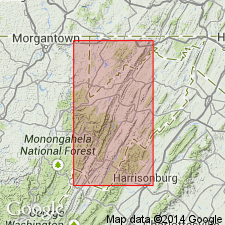
- Usage in publication:
-
- Foreknobs Formation
- Modifications:
-
- Named
- Dominant lithology:
-
- Sandstone
- Siltstone
- AAPG geologic province:
-
- Appalachian basin
Summary:
Unit here named for the topographic feature called Fore Knobs of Allegheny Front and assigned as upper formation of the newly named Greenland Gap Group, which replaces Chemung Formation in the report area. Unit exposed in outcrops from Allegany Co., MD, to Highland Co., VA. Contains abundant massive sandstones; considerable siltstone; substantial "redbeds" of brownish-gray sandstone, siltstone, and shale containing scattered marine fossils; and occasional quartz-pebble conglomerate or conglomeratic sandstone beds. Unit formerly called upper sandy part of Chemung Formation. Lower Foreknobs probably correlates with Elkins Member of Chemung Formation (Reger, 1928, 1931) west of Allegheny Front in Randolph Co. Subdivided into (ascending) Mallow Member, Briery Gap Sandstone Member, Blizzard Member, Pound Sandstone Member, and an unnamed member. Underlies Hampshire Formation; disconformably overlies Scherr Formation (named). 1321 ft (403 m) thick at type section; ranges to 585 m. Age is Late Devonian. Formation boundary is probably time-transgressive, becoming younger to the southwest.
Source: GNU records (USGS DDS-6; Reston GNULEX).
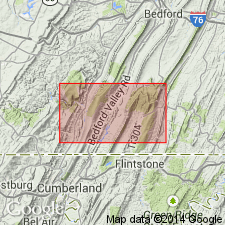
- Usage in publication:
-
- Foreknobs Formation*
- Modifications:
-
- Areal extent
- AAPG geologic province:
-
- Appalachian basin
Summary:
Scherr and Foreknobs Formations of Dennison (1970) here geographically extended into south-central PA and adopted for use by the USGS in the report area and in their type locality state of WV. Greenland Gap Group not used in this report.
Source: GNU records (USGS DDS-6; Reston GNULEX).
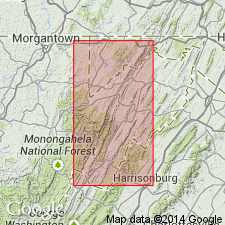
- Usage in publication:
-
- Foreknobs Formation
- Modifications:
-
- Revised
- AAPG geologic province:
-
- Appalachian basin
Summary:
Red Lick Member here named and assigned to Foreknobs Formation as uppermost unit, overlying Pound Sandstone Member. Southwest of Rte 250 in VA, Foreknobs is not divided into members.
Source: GNU records (USGS DDS-6; Reston GNULEX).
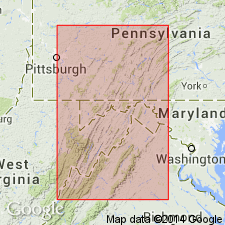
- Usage in publication:
-
- Foreknobs Formation*
- Modifications:
-
- Areal extent
- AAPG geologic province:
-
- Appalachian basin
Summary:
Scherr and Foreknobs Formations extended into west-central VA for USGS use. Greenland Gap Group not used in this report.
Source: GNU records (USGS DDS-6; Reston GNULEX).
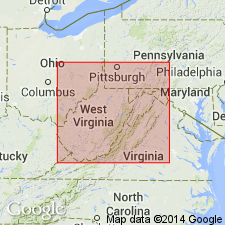
- Usage in publication:
-
- Foreknobs Formation
- Modifications:
-
- Areal extent
- AAPG geologic province:
-
- Appalachian basin
Summary:
Foreknobs and Scherr Formations are not recognized in the subsurface of WV; therefore, Greenland Gap is reduced to formation rank west of the Allegheny Front where it replaces use of the term "Chemung." Uppermost members of the Foreknobs (Red Lick and Pound) are retained as members of the Greenland Gap Formation.
Source: GNU records (USGS DDS-6; Reston GNULEX).
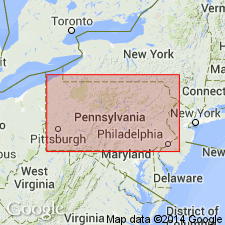
- Usage in publication:
-
- Foreknobs Formation
- Modifications:
-
- Revised
- Overview
- Areal extent
- AAPG geologic province:
-
- Appalachian basin
Summary:
In south-central PA, the Minnehaha Springs Member of the Scherr Formation and the Mallow, Briery Gap, Blizzard, Pound, and Red Lick Members of the Foreknobs Formation of the Greenland Gap Group are recognized. The Foreknobs is composed of variegated sandstone, siltstone, and shale with local quartz-pebble conglomerate. Unit ranges from 1320 to 2260 ft thick and averages about 1800 ft.
Source: GNU records (USGS DDS-6; Reston GNULEX).
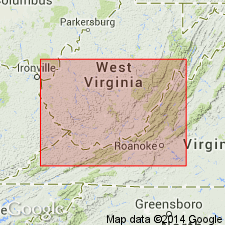
- Usage in publication:
-
- Foreknobs Formation
- Modifications:
-
- Areal extent
- AAPG geologic province:
-
- Appalachian basin
Summary:
The term Foreknobs Formation is not used in the stratigraphic cross section south of Gap Mills, WV. Arbitrary cutoffs are drawn where diagnostic characteristics are lost by facies change. The Mallow Member coarsens upward and also becomes finer grained toward the southwest. Cutoffs of the base of the Mallow Member are drawn between Alleghany and White Sulphur Springs. All sandstone in the Mallow, Briery Gap, Blizzard, and Pound Members is lost southwest of White Sulphur Springs resulting in an arbitrary cutoff of the base of the Foreknobs, which jumps up to the base of the Red Lick Member near Gap Mills. The Red Lick then loses all of its sandstone between Gap Mills and Bluefield.
Source: GNU records (USGS DDS-6; Reston GNULEX).
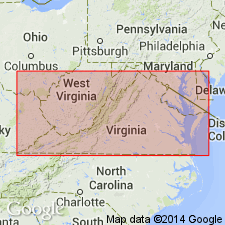
- Usage in publication:
-
- Foreknobs Formation
- Modifications:
-
- Areal extent
- AAPG geologic province:
-
- Appalachian basin
Summary:
Foreknobs Formation used in the Catawba syncline of southwestern VA to encompass the lower part of those rocks previously mapped as Chemung by Amato (1974). All five members are present. Overlies Brallier Formation, as Scherr Formation is not recognized in this area. Underlies Hampshire Formation, which replaces usage of the upper Chemung in this area.
Source: GNU records (USGS DDS-6; Reston GNULEX).
For more information, please contact Nancy Stamm, Geologic Names Committee Secretary.
Asterisk (*) indicates published by U.S. Geological Survey authors.
"No current usage" (†) implies that a name has been abandoned or has fallen into disuse. Former usage and, if known, replacement name given in parentheses ( ).
Slash (/) indicates name conflicts with nomenclatural guidelines (CSN, 1933; ACSN, 1961, 1970; NACSN, 1983, 2005, 2021). May be explained within brackets ([ ]).

